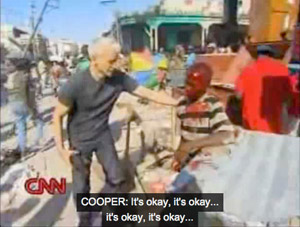| The business of suffering |
 |
| Written by The British Journal of Photography |
|
Today, 17 years later, the ethical questions over photojournalists' role in the midst of human suffering persist. On 12 January Haiti was hit by one of the worst earthquakes in its history, which killed more than 150,000 people. Dozens of journalists and photographers rushed to the island to cover the devastation. Countless images followed and, initially the public focused on the suffering they saw in them, arguably helping raise millions of pounds in donations. But soon the debate shifted towards the journalists. Were there too many of them? Were they helping? Was their work exploitative?
The questions gained traction after a video of CNN correspondent Anderson Cooper - who caught one of the last civilian planes headed to Haiti - featured on the news network, showing him rescuing a bleeding boy from what he claimed was a potentially lethal mob. Haitian photojournalist Daniel Morel was highly critical of Cooper's actions, accusing him, and other journalists, of 'playing with people' in Lens, the New York Times' photography blog. 'CNN is playing with people,' he added. 'Anderson Cooper is playing with people. They're doing show business with people's lives here.'
Back in UK, picture editors are also being accused of engaging in 'disaster pornography'. But are they? I don't think so. Apart from a couple of exceptions, most of them are simply doing their job - showing the extent of the devastation. Why should we be spared images of corpses when the earthquake has killed so many that dead bodies now litter the streets? The challenge, as Jessie De Witt of the New York Times puts it, is to get the right balance, but I think this has largely been achieved.
In the next few weeks - maybe even days - Haiti will slowly disappear from the headlines, just as the devastation caused by Hurricane Katrina, the South-East Asian tsunami and the recent Chinese earthquake faded from view. That should be a cause for outrage, not relevant reporting on the facts.
Olivier Laurent, News editor
|

 In 1993 Kevin Carter found himself mired in controversy over an image he shot in Sudan. The photograph showed a vulture watching a starving young Sudanese girl, seemingly waiting for her to die and its chance to pounce. The image was published in the New York Times on 26 March and immediately sparked numerous protests from readers all over the world, accusing Carter of taking advantage of the girl's plight and asking why he had photographed her rather than helping. Carter won the Pulitzer Prize the following year for his image, but in July 1994 he killed himself.
In 1993 Kevin Carter found himself mired in controversy over an image he shot in Sudan. The photograph showed a vulture watching a starving young Sudanese girl, seemingly waiting for her to die and its chance to pounce. The image was published in the New York Times on 26 March and immediately sparked numerous protests from readers all over the world, accusing Carter of taking advantage of the girl's plight and asking why he had photographed her rather than helping. Carter won the Pulitzer Prize the following year for his image, but in July 1994 he killed himself.


